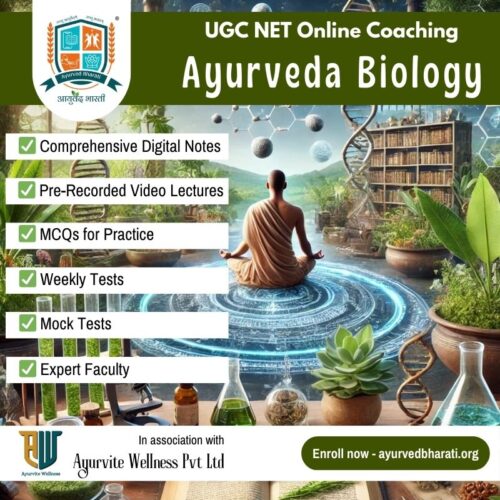UGC NET Ayurveda Biology coaching
- Course Validity: 12 months
- Resources: LMS and Digital Library Access – Pre-recorded video lectures in Hindi, Downloadable Digital Notes in English, MCQs & Mock Tests
- Content: Covers entire UGC NET Ayurveda Biology syllabus
- Language: Lectures – majorly in Hindi, Reading materials & test series in English
UGC NET Ayurveda Biology Coaching – Key Highlights
- Mode: 100% Online
- Study Materials: Comprehensive downloadable digital notes, pre-recorded videos, MCQs for practice, mock tests, printed book set of 3 books (can be purchased, not included in this course fee).
- Syllabus: Covers all 10 units recommended by UGC NET
- Expert Faculty: Experienced professionals specializing in Ayurveda and biology.
- Flexible Learning: Self-paced study with recorded lectures and accessible resources.
- Designed for Beginners & Experts: Tailored content for all levels of aspirants.
Click here for demo lessons/ videos
Limited Seats, have you booked your’s?
Q51. Which discipline explains time of medicine administration in Ayurveda?
Option A. Network pharmacology
Option B. Pharmacogenomics
Option C. Chrono-pharmacology
Option D. Clinical genomics
Correct Ans – Option C (Chrono-pharmacology)
Explanation –
Chrono-pharmacology studies the interaction of biological rhythms (like circadian rhythm) with drug effects, aligning with Kala and timing principles in Ayurveda.
Q52. Which of the following are NOT types of Marma described in Ayurveda?
A. Instant fatal
B. Eventually fatal
C. Pain inflicting
D. Fire dampening
E. Dosha vitiating
Correct Ans – Option 2 (B and C Only)
Explanation –
Pain-inflicting and eventually fatal are valid types.
Fire dampening and Dosha vitiating are not classical Marma types.
Q53. Pathogen-disease pair incorrectly matched:
A. E. histolytica – Amoebiasis
B. Wuchereria – Elephantiasis
C. Ascaris – Ringworms
D. Aspergillus – Warts
E. P. vivax – Cerebral malaria
Correct Ans – Option 4 (A, B and E Only)
Explanation –
- C. Ascaris → Roundworm, not ringworm
- D. Aspergillus causes respiratory diseases, not warts
- E. P. vivax causes benign tertian malaria, not cerebral (P. falciparum does)
Q54. Pangvandhu Nyaya (Blind-Lame theory) refers to:
Option A. Man and Atman
Option B. Indriya and Man
Option C. Atman and Indriya
Option D. Sharir and Aayu
Correct Ans – Option B (Indriya and Man)
Explanation –
The Pangvandhu Nyaya explains mutual interdependence using the metaphor of blind and lame. Mind cannot function without senses, and vice versa.
Q55. Process used for preparation of Bhasmas in Ayurveda:
Option A. Puta
Option B. Urdhav Patana
Option C. Murchana
Option D. Sattva Patana
Correct Ans – Option C (Murchana)
Explanation –
Murchana is a detoxification or purification step before the Shodhana or calcination (puta) in Bhasma preparation to reduce toxicity and enhance efficacy.
Q56. The pathway for cellular respiration is in the following order:
A. Generation of Acetyl-CoA
B. Generation of reducing equivalents
C. Tri-carboxylic acid cycle (TCA)
D. Action of F1Fo ATPase
E. Co-transport of primary biomolecules
Correct Ans – Option 2 (E, A, C, B, D)
Explanation –
- E. Co-transport of primary biomolecules into the cell
- A. Acetyl-CoA is generated via glycolysis & pyruvate oxidation
- C. TCA cycle (Kreb’s cycle) begins
- B. Reducing equivalents (NADH/FADH₂) are produced
- D. F1Fo ATPase (ATP synthase) produces ATP
Q57. How many types of Dhatvagni are described in Ayurveda?
Option A. Five
Option B. Three
Option C. Seven
Option D. Thirteen
Correct Ans – Option A (Seven)
Explanation –
There are 7 types of Dhatvagni—one for each Dhatu:
Rasa, Rakta, Mamsa, Meda, Asthi, Majja, and Shukra.
Q58. Panchabhautik composition of “Kashaya Rasa” is:
Option A. Vayu + Akasha
Option B. Prithvi + Akasha
Option C. Prithvi + Vayu
Option D. Vayu + Jala
Correct Ans – Option B (Prithvi + Akasha)
Explanation –
According to Ayurveda, Kashaya (astringent) rasa is formed by Prithvi and Akasha Mahabhuta—which gives it a drying and binding quality.
Q59. Which of the following subtypes of Kapha is related to lubrication of joints?
Option A. Tarpak
Option B. Shleshak
Option C. Avalambak
Option D. Kledak
Correct Ans – Option B (Shleshak)
Explanation –
Shleshak Kapha resides in the joints (sandhi) and is responsible for lubrication and smooth articulation.
Q60. Match List-I (Virus species) with List-II (Genus):
| Virus | Genus |
| A. Chandipura Virus | III. Vesiculovirus |
| B. Colorado tick fever virus | II. Orbivirus |
| C. Japanese encephalitis virus | I. Flavivirus |
| D. Chikungunya virus | IV. Alphavirus |
Correct Ans – Option 3 (A-I, B-III, C-IV, D-II)
Explanation –
- Chandipura Virus → Vesiculovirus
- Colorado tick fever virus → Orbivirus
- Japanese Encephalitis → Flavivirus
- Chikungunya → Alphavirus

